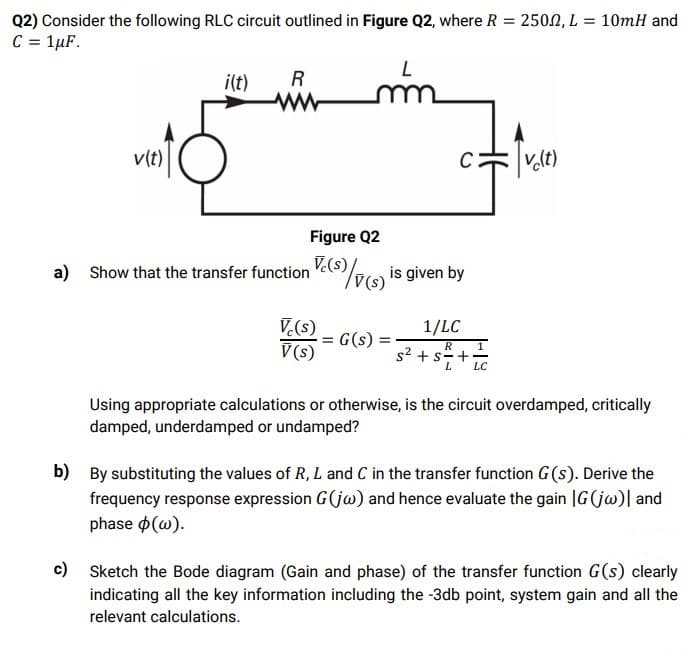C = 1µF. %3D L i(t) R v(t) C v.lt) Figure Q2 a) Show that the transfer function Yc(sc is given by V(s)/ V.(s) = G(s) V(s) 1/LC R 1 s2 + s-+ LC Using appropriate calculations or otherwise, is the circuit overdamped, critically damped, underdamped or undamped? b) By substituting the values of R, L and C in the transfer function G(s). Derive the frequency response expression G(ja) and hence evaluate the gain |G(ja)| and phase p(w). c) Sketch the Bode diagram (Gain and phase) of the transfer function G(s) clearly indicating all the key information including the -3db point, system gain and all the relevant calculations.
C = 1µF. %3D L i(t) R v(t) C v.lt) Figure Q2 a) Show that the transfer function Yc(sc is given by V(s)/ V.(s) = G(s) V(s) 1/LC R 1 s2 + s-+ LC Using appropriate calculations or otherwise, is the circuit overdamped, critically damped, underdamped or undamped? b) By substituting the values of R, L and C in the transfer function G(s). Derive the frequency response expression G(ja) and hence evaluate the gain |G(ja)| and phase p(w). c) Sketch the Bode diagram (Gain and phase) of the transfer function G(s) clearly indicating all the key information including the -3db point, system gain and all the relevant calculations.
Introductory Circuit Analysis (13th Edition)
13th Edition
ISBN:9780133923605
Author:Robert L. Boylestad
Publisher:Robert L. Boylestad
Chapter1: Introduction
Section: Chapter Questions
Problem 1P: Visit your local library (at school or home) and describe the extent to which it provides literature...
Related questions
Question

Transcribed Image Text:Q2) Consider the following RLC circuit outlined in Figure Q2, where R = 2502, L = 10mH and
C = 1µF.
i(t)
R
v(t)
v.lt)
Figure Q2
Show that the transfer function Ve(S7e is given by
V.(s)
V(s)
a)
V.(s)
G(s)
V (s)
1/LC
R
1
s2 + s=+.
LC
Using appropriate calculations or otherwise, is the circuit overdamped, critically
damped, underdamped or undamped?
b)
By substituting the values of R, L and C in the transfer function G (s). Derive the
frequency response expression G(jw) and hence evaluate the gain |G(jw)| and
phase o(w).
c)
Sketch the Bode diagram (Gain and phase) of the transfer function G(s) clearly
indicating all the key information including the -3db point, system gain and all the
relevant calculations.
Expert Solution
This question has been solved!
Explore an expertly crafted, step-by-step solution for a thorough understanding of key concepts.
Step by step
Solved in 4 steps with 1 images

Knowledge Booster
Learn more about
Need a deep-dive on the concept behind this application? Look no further. Learn more about this topic, electrical-engineering and related others by exploring similar questions and additional content below.Recommended textbooks for you

Introductory Circuit Analysis (13th Edition)
Electrical Engineering
ISBN:
9780133923605
Author:
Robert L. Boylestad
Publisher:
PEARSON

Delmar's Standard Textbook Of Electricity
Electrical Engineering
ISBN:
9781337900348
Author:
Stephen L. Herman
Publisher:
Cengage Learning

Programmable Logic Controllers
Electrical Engineering
ISBN:
9780073373843
Author:
Frank D. Petruzella
Publisher:
McGraw-Hill Education

Introductory Circuit Analysis (13th Edition)
Electrical Engineering
ISBN:
9780133923605
Author:
Robert L. Boylestad
Publisher:
PEARSON

Delmar's Standard Textbook Of Electricity
Electrical Engineering
ISBN:
9781337900348
Author:
Stephen L. Herman
Publisher:
Cengage Learning

Programmable Logic Controllers
Electrical Engineering
ISBN:
9780073373843
Author:
Frank D. Petruzella
Publisher:
McGraw-Hill Education

Fundamentals of Electric Circuits
Electrical Engineering
ISBN:
9780078028229
Author:
Charles K Alexander, Matthew Sadiku
Publisher:
McGraw-Hill Education

Electric Circuits. (11th Edition)
Electrical Engineering
ISBN:
9780134746968
Author:
James W. Nilsson, Susan Riedel
Publisher:
PEARSON

Engineering Electromagnetics
Electrical Engineering
ISBN:
9780078028151
Author:
Hayt, William H. (william Hart), Jr, BUCK, John A.
Publisher:
Mcgraw-hill Education,